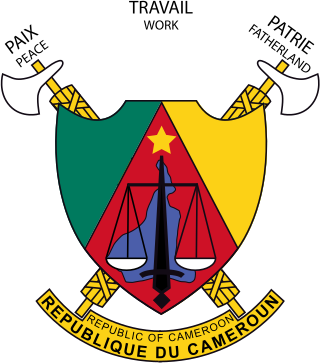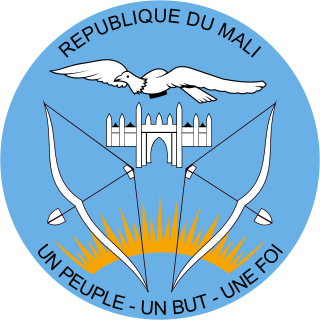Related Research Articles
A constitutional amendment is a modification of the constitution of a polity, organization or other type of entity. Amendments are often interwoven into the relevant sections of an existing constitution, directly altering the text. Conversely, they can be appended to the constitution as supplemental additions, thus changing the frame of government without altering the existing text of the document.

France is a unitary semi-presidential republic with a bicameral legislature. Public officials in the legislative and executive branches are either elected by the citizens or appointed by elected officials. Referenda may also be called to consult the French citizenry directly on a particular question, especially one which concerns amendment to the Constitution.

Elections in Togo take place within the framework of a presidential system. Both the President and the National Assembly are directly elected by voters. Togo is a one party dominant state with the Union for the Republic in power.

There have been fifteen referendums in Lithuania since it declared independence from the Soviet Union on 11 March 1990. Because of strict requirements, only four referendums have been successful. Older Lithuanian laws required that more than half of all registered voters would vote in support of a proposal for it to become a binding obligation to the government. In 2002, this requirement was lowered to one third of all registered voters.

A referendum on creating an Islamic Republic was held in Iran on 30 and 31 March 1979. Ayatollah Ruhollah Khomeini did not allow an open referendum, insisting that the Iranian population had chosen an "Islamic Republic" already by demonstrating against the Shah. In response, political parties such as the National Democratic Front and the Organization of Iranian People's Fedai Guerrillas boycotted the referendum.

A constitutional referendum was held in France on 21 October 1945. Voters were asked whether they approved of the Assembly elected on the same day serving as a Constituent Assembly, and whether until a new constitution was approved, the country would be governed according to a proposed set of laws that appeared on the ballot paper. If the first proposal had not been approved, the Third Republic would have been restored, but its approval led to the elected Assembly drafting a constitution and proposing it to the people a year later, resulting in the creation of the Fourth Republic. Both were approved by wide margins with a turnout of 79.8%.

A constitutional referendum was held in France on 5 May 1946. Voters were asked whether they approved of a new draft Constitution proposed by the Constituent Assembly elected in 1945.

A constitutional referendum was held in France on 13 October 1946. Voters were asked whether they approved of a new constitution proposed by the Constituent Assembly elected in June. Unlike the May referendum, which saw a previous constitutional proposal rejected, the new Constitution of 27 October 1946 was accepted by 53% of voters, and brought the Fourth Republic into existence. Voter turnout was 68%.

A constitutional referendum was held in France on 28 September 1958. Voters were asked whether they approved of the adoption of a constitution for the French Fifth Republic written by Charles de Gaulle. It was overwhelmingly approved, with 82.6% in favour. Voter turnout was 84.9% in metropolitan France and 79.8% overall.

A referendum on the method of the election of the president was held in France on 28 October 1962. The question was whether to have the President of the French Republic elected by direct popular vote, rather than by an electoral college. It was approved by 62.3% of voters with a 77.0% turnout. The reform was controversial because it strengthened the executive at the expense of Parliament, and because of the disputed constitutionality of the procedure used.

A popular referendum, depending on jurisdiction also known as a citizens' veto, people's veto, veto referendum, citizen referendum, abrogative referendum, rejective referendum, suspensive referendum, and statute referendum, is a type of a referendum that provides a means by which a petition signed by a certain minimum number of registered voters can force a public vote (plebiscite) on an existing statute, constitutional amendment, charter amendment, or ordinance; in its minimal form, it simply obliges the executive or legislative bodies to consider the subject by submitting it to the order of the day. It is a form of direct democracy.

A constitutional referendum was held in Togo on 30 December 1979, alongside simultaneous general elections. The changes to the constitution would establish the Third Togolese Republic and make the country a presidential republic and a one-party state, and were approved by 99.87% of voters with a 99.4% turnout. The constitution came into force on 12 January 1980.

A constitutional referendum was held in the Republic of Upper Volta on 15 March 1959. Unlike almost all other French colonies in Africa, the new constitution would make the territory parliamentary republic with a unicameral National Assembly. It was approved by 80% of voters with a 68.7% turnout.
A referendum is a direct vote in which an entire electorate is asked to either accept or reject a particular proposal. This article summarises referendum laws and practice in various countries.

The constitution of the French Fifth Republic allows three types of referendum:
- At the national level, a legislative referendum on the initiative of President of the French Republic on a proposal by the Cabinet or the Parliament ;
- Locally, a local referendum initiative.
- The Constitutional Law of 23 July 2008 provides a shared initiative referendum.

A constitutional referendum was held in French Gabon and Moyen Congo on 5 May 1946 as part of the wider French constitutional referendum. The proposed new constitution was rejected by 64% of voters in the territory, and 53% of voters overall.

A constitutional referendum was held in French Cameroons on 5 May 1946 as part of the wider French constitutional referendum. The proposed new constitution was rejected by 81% of voters in the territory, and 53% of voters overall.

A constitutional referendum was held in French Sudan and Niger on 21 October 1945 as part of the wider French constitutional referendum. The first question on the new French National Assembly serving as a constituent assembly was approved by 97% of voters, whilst the temporary constitution proposed in the second question was approved by 86% of voters. Both proposals were also approved in the overall vote. Voter turnout was 79.3%.

A constitutional referendum was held in French Sudan and Niger on 5 May 1946 as part of the wider French constitutional referendum. The proposed new constitution was rejected by 48% of voters in the two territories and by 53% of the overall vote. Voter turnout was 58%.
A constitutional referendum was held in French Sudan and Niger on 13 October 1946 as part of the wider French constitutional referendum. The proposed new constitution was rejected by 45% of voters in the two territories, but approved by 57.4% of the overall vote. Voter turnout was 51%.
References
- ↑ Sternberger, D, Vogel, B, Nohlen, D & Landfried, K (1969) Die Wahl der Parlamente: Band II: Afrika, Erster Halbband, p1047